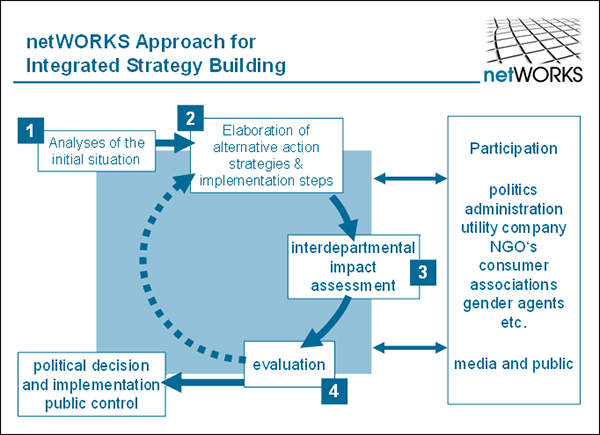netWORKS' integrated strategy formulation approach
The challenges of long-term strategy formulation
Ensuring a comprehensive and high-quality infrastructure is undisputedly a chief municipal responsibility. However, the basic conditions to fulfil this task have changed. For instance, financial straits increasingly limit cities' scope for action. Furthermore, the European Commission's competition policies cause disturbance, as they conflict with the right to self-government granted to municipalities under constitutional law. Moreover, provision of economically and ecologically efficient water services has been a legally stipulated requirement since the adoption of the EU Water Framework Directive (EU-WRRL). Additionally, demographic change poses a further technical-economic challenge. When population numbers fall, existing supply and management structures need to be adapted. In view of these transformation processes, municipal political and administrative decision-makers must ask themselves how to secure supply and waste management adequately and sustainably in the future. Which strategies will best ensure supply and waste management in the future? In the long term, is it wise for municipalities to privatise their water provision? What opportunities do alternative forms of regional cooperation offer? Would it not be better to leave the provision of so-called basic services to municipal companies? Finally, possible alternatives were evaluated from the perspective of a sustainable infrastructure management.
Aids to decision-making for municipalities
The research association netWORKS has developed an integrated strategy formulation approach to support municipal decision-making. It aims in particular at assisting municipal politicians, departmental heads and chief officials in reaching decisions in order to enable them to detect and assess necessary action ensuing from particular decisions at an early stage. It consists of a sequence of four structuring steps:
- report on the status quo and problem analysis,
- formulation of practical strategies and their possible implementation,
- interdepartmental impact appraisal,
- evaluation of selected strategies on the basis of so-called guiding principles. This aims to better identify where adaptation is required in order to further develop and optimise the strategy.
Of course, this schematically clear differentiation of steps is not possible in real political decision-making processes. Moreover, in reality, political decision-making processes are not based solely on objectively rational criteria. Instead, the logics of micro- and power politics play an important role as well. Nevertheless, the steps proposed support the development of a certain structure.
The netWORKS approach
The decision-making process should follow the netWORKS’ integrated strategy formulation approach. Additionally, it should be applied in various phases and with a hierarchical implementation procedure. This process can be characterised as the sum of required steps, starting with the identification of the problem situation and culminating in the decision. By proceeding in this manner it is possible to predict the possible consequences of certain decisions. In this context, the third step, namely the interdisciplinary and interdepartmental impact appraisal, assumes a particularly important role. The primary goal regarding this step is to anticipate the possible effects of particular decisions. This entails examining opportunities, restrictions and unintended negative consequences which may have been caused by specific decisions. This information is subsequently evaluated in a fourth step. The outcome of this assessment may reveal deficits and problems which suggest a modification of the selected strategy. Performing the procedure repeatedly may prove its worth and even necessity in order to achieve the best possible decision. In this respect, decision-making is not a process which is performed only once. On the contrary, given certain circumstances, complex decision-making scenarios and the possible impact of particular decisions make it necessary to go through alternative possibilities.

Figure 1: netWORKS integrated strategy formulation approach*
*Source: netWORKS research association


